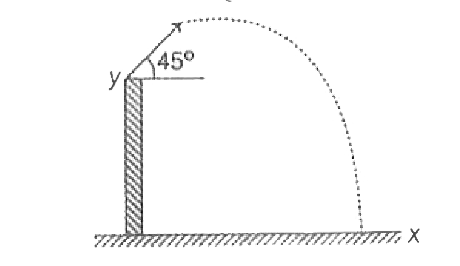A ball of mass 0.2kg is thrown from a height of 1m and with an initial velocity of √10m/s at an angle of 45∘ with the horizontal. Assuming, acceleration due to gravity g=10m/s2, ten modulus of momentum increment during the total time of motion in kg m/s is Solution in Telugu
2+√10√10
1+√10√5
1+√5√5
√5−1√5
The correct Answer is:C
There is no change in velocity in x-direction so momentum change occurs onhly in y-direction.

Now initial momentum in y direction is
py(initial) = mvy=0.2(√10sin45∘ˆj)=1√5.ˆjkg−ms−
Final mmentum in y-direction is
pyfinal=mvy=m(√u2+2gh)
=(0.2√(52)+2(−10)(−1)ˆj=−1ˆjkg−ms−1 (downwards)
So, change in momentum
Δp=py(final)−px(initial)=−1ˆj−1√5ˆj
=−(1+1√5)ˆjkg−ms−1
⇒=|Δp|=1+1√5=1+√5√5
Topper's Solved these Questions
Similar Questions
Assertion (A) When we bounce a ball on the ground, it comes to rest after a few bounces, losing all its energy. This is an example of violation of conservation of energy.
Reason (R) Energy can change from one form to another but the total energy is always conserved.
Which of the following is true?View SolutionMatch the following fundamental forces of nature with their relative strength.
List-IList-II(A)Strong nuclear force(i)10−2(B)Weak nuclear force(ii)1(C)Elextromagnetic force(iii)10−39(D)Gravitational force(iv)10−13
The correct match is04:43View SolutionA body of mass m is thrown at an angle to the horizontal with the initial velocity v0. Assuming the air drag to be negligible, find:
(a) the momentum increment Δp that the body acquires over the first t seconds of motion,
(b) the modulus of the momentum increment Δp during the total time of motion.03:26View SolutionA ball is thrown from the top of a tower with an initial velocity of 10 m//s at an angle of 30∘above the horizontal. It hits the ground at a distance of 17.3 m from the base of the tower. The height of the tower (g=10m/s2) will be
03:34View SolutionA projectile is thrown with a velocity of 20 m//s, at an angle of 60^(@) with the horizontal. After how much time the velocity vector will make an angle of 45^(@) with the horizontal (in upward direction) is (take g= 10m//s^(2))-
07:27View SolutionWhen a ball is thrown vertically upwards it goes through a distance of 19.6 m. Find the initial velocity of the ball and the time taken by it to rise to the high point (Acceleration due to gravity g=9.8 m/s^(2) )
03:07View SolutionA body of mass m=1kg is thrown at an angle θ=45∘ to the horizontal with the initial velocity u=10m/s. Find the mean power delivered by gravity over the whole time of motion of the body.
07:21View Solutionएक गेंद 15 मीटर/सेकण्ड के वेग से क्षैतिज से 30∘ का कोण बनाते हुए फेकि जाती है | ज्ञात कीजिए : (i) गेंद की उड़ान का समय तथा (ii) गेंद द्वारा प्राप्त अधिकतम ऊँचाई | (g = 10 मीटर/सेकण्ड2)
04:47View SolutionA tennis ball is thrown up and reaches a height of 4.05 m before coming down. What was its initial velocity? How much total time will it take to come down? Assume g=10m/s2
01:45View SolutionA tennis ball is thrown up and reaches a height of 4.05 m before coming down. What was its initial velocity? How much total time will it take to come down? Assume g=10m/s2
04:02View SolutionFind the total energy of a body of 5 kg mass , which is at a height of 10 m from the earth and falling downwards straightly with a velocity of 20 m/s (Take the acceleration due to gravity as 10m/s2 )
04:39View SolutionA small ball is thrown at an angle 45∘ to the horizontal with an initial velocity of 2√2m/s. The magnitude of mean velocity averaged over the first 2 s is [take, acceleration due to gravity, g=10m/s2]
View Solution0.5 kg द्रव्यमान की एक गेंद को प्रारंभिक वेग 14 m/s से ऊपर की ओर फेंकने पर यह अधिकतम 8m ऊँचाई तक पहुँचती है तो गति के दौरान गेंद पर लगने वाले वायु घर्षण के कारण कितनी ऊर्जा व्यय होगी।
03:41View SolutionA ball is thrown at a speed of 20 m/s at an angle of 30∘ with the horizontal. The maximum height reached by the ball is (use g=10m/s2)
04:09View SolutionA ball is thrown from the top of a tower with an initial velocity of 10 m//s at an angle of 30^(@) above the horizontal. It hits the ground at a distance of 17.3 m from the base of the tower. The height of the tower (g=10m//s^(2)) will be
03:34View Solution

